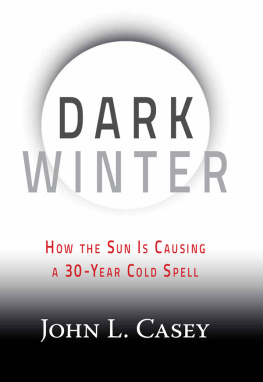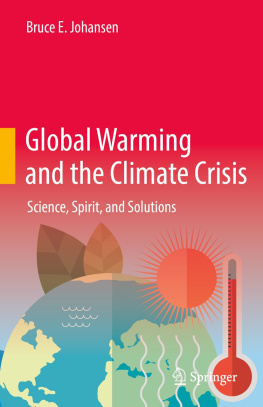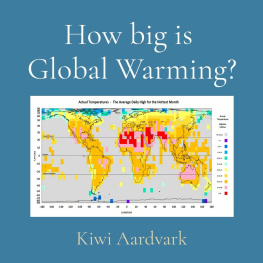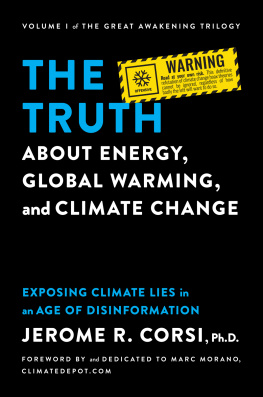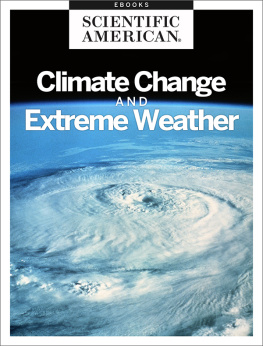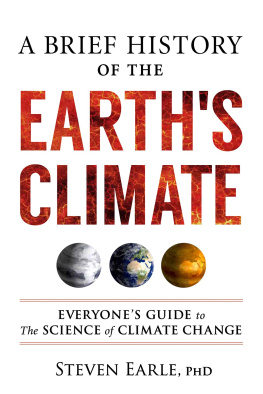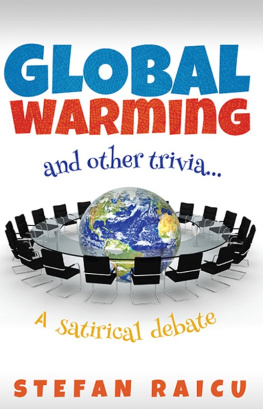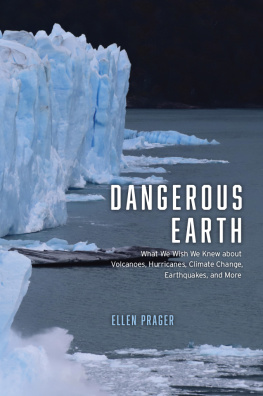Dark Winter
How the Sun Is Causing a 30-Year Cold Spell
By John L. Casey
Dark Winter: How the Sun Is Causing a 30-Year Cold Spell
2014 Humanix Books
All rights reserved
No part of this book may be reproduced or transmitted in any form or by any means, electronic or mechanical, including photocopying, recording, or by any other information storage and retrieval system, without written permission from the publisher. For information, contact:
Humanix Books
P.O. Box 20989
West Palm Beach, FL 33416
USA
www.humanixbooks.com
email:
Humanix Books is a division of Humanix Publishing LLC. Its trademark, consisting of the words Humanix Books is registered in the U.S. Patent and Trademark Office and in other countries.
Printed in the United States of America and the United Kingdom.
ISBN (E-book) 978-1-63006-023-7
ISBN (Hardcover) 978-1-63006-035-0
Library of Congress Control Number 2014939082
Contents
T he matter of climate change has been a perplexing problem for decades. Do human behaviors and social dynamics follow environmental changes, or is it the contrary that human activity is the leader of the relationship between humans and the environment? The modern, popular belief supported by the media, politicians, and some scientists is that humans control the environment. Is it true?
Of course not! The Earths biosphere development is a result of about three billion years of changes in the environment of our planet. The final product of this evolution up to this moment is the human species. Thus, humans are a result of these environmental changes, not the cause of them.
One of the key features of climate change is relatively well-expressed cycles. These cycles are caused mainly by celestial factors: variations of the Earths motion, solar activity, and so on. The Milankovitch theory describes the cyclic variations of Earth orbital and rotational motion parameters in cycles up to 120,000 years. But while the theory explains satisfactorily such important climatic events as the great ice epochs and other large climate cycles, it is impossible to use as a tool for understanding the shorter climate cycles, such as those lasting from 2 to 10,000 years.
The most important of these are the so-called cycles of the little ice epochs (2,200 to 2,400 years), as well as climate oscillations of about 200 years. The little ice epoch cycle was first detected by geologists George Denton and Wibjrn Karln at the end of the 1960s by analysis of the dynamics of the edges of high mountain ice fields. In addition, this 2,200- to 2,400-year cycle has been found in a large number of indirect climate parameters: the world ocean level changes, the level of isolated basins like the Caspian Sea, and the growth of stalactites and stalagmites, as well as in many tree samples. The 2,200- to 2,400-year cycle is a major feature of the global climate. It corresponds to temperature variations of 2C to 2.5C. The little ice ages are the starting epochs of this cycle. The last one occurred in the fifteenth to seventeenth century.
The Bicentennial Cycle, with a duration of about 200 years, comes with a global temperature change of 0.5C to 1C and is also well-expressed in global climates, but mainly in the inner parts of continents for example, Eurasia and North America. There is now much evidence that the 2,200- to 2,400-year cycle and the 200-year cycle, as well as almost all other relatively short climatic cycles, are caused by processes on the sun.
There have been many scientists going back to the 1950s and 1960s who have established the relationship between solar climate and 200-year cycles (e.g., many experts before 1963 in the former USSR and Czechoslovakia; many authors before 1963; Paul Damon of the United States in 1968; and A. Bonov of Bulgaria in 1968). The relationship between the Maunder-type minimums (or prolonged sunspot minimums) of the solar 2,200- to 2,400-year cycle and the little ice epochs was well-established and described at the beginning of the 1990s in the papers of Damon and Charles Sonett in the United States and Valentin Dergachev and Vladimir Chistyakov in Russia.
However, the role of the sun in climate change up to this moment has been studied and debated by only a relatively small group of scientists mainly astrophysicists, geophysicists, and paleoclimatologists. It is a forbidden theme for researchers connected to the World Meteorological Organization (WMO) and the United Nations Intergovernmental Panel on Climate Change (IPCC), as well as for the media. As a result, the influence of the sun on climate change is almost unknown for the great majority of people not only in the United States but in the rest of the world. An additional problem is a lack of awareness in education in the fields of physics, astronomy, geology, and other natural and space-oriented disciplines. This learning deficit is seen in our middle schools, colleges, and most universities, except in the most advanced and specialized institutions.
In this regard, John L. Caseys Dark Winter is a very useful book. It is written for the layman and thus is not a scientific textbook. Its style speaks very well to educated but nonscientific readers. It is, therefore, ideal for students in high schools, colleges, and universities; educators; economists; agro- and hydro-engineers; developers of energy strategies; politicians; businessmen; and any others who want to understand the fuller picture of climate change. It is especially recommended to journalists who are interested in reporting on the field of climate change.
Caseys primary argument is that a longtime downward tendency in solar activity dynamics has already started, and it will cause a corresponding climate cooling similar to the Dalton Minimum. I agree, though the real cooling effect, in my opinion, would more probably be 0.7C to 0.8C. Others have also predicted this coming cold era as forecast by Casey, including M. V. Fyodorov et al. (Solar Physics, 1996), Drs. Boris Komitov and B. P. Bonev (Astrophysical Journal, 2001), and M. G. Ogurtsov (Solar Physics, 2005).
Casey presents a thought-provoking analysis of the social conditions in Europe and the United States at the beginning of nineteenth century and their relation to the Dalton Minimum and corresponding climate situation. The effect of Indonesias Mount Tambora eruption in 1815 is also discussed. The book brings up, if only briefly, an interesting question: Is there a relationship between solar activity and Earth tectonics? According to a 2006 study by the Russian geologists Rogosin and Shestopalov, the overall seismic activity of the Earth essentially increases during these long-term solar minimums, just as Casey describes. In this case, I believe that Casey is correct in that there is an increasing probability of major earthquakes and volcanic eruptions, especially in the Pacific region, during this next solar minimum.
The economic and social effects of the forthcoming solar minimum are well discussed in the book. It should be emphasized that major demographic and social events in the history of the Old World (i.e., Europe, Asia, and Africa) during the last 5,000 years coincide strongly with solar activity and corresponding climatic changes. For example, the Renaissance and little ice age epochs coincide with the Maunder Minimums. These periods saw the largest gains in human progress, but they also saw significant food and energy shortages. I have also found this correlation in my own research.
The problems brought on by this next period of climate change, which Casey ably discusses in

